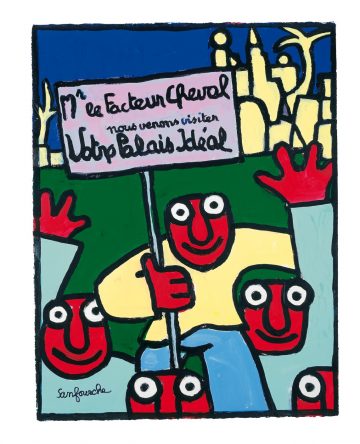Joseph SANFOURCHE 1929
Jean-Joseph Sanfourche, known simply as Sanfourche, was born in 1929 in Bordeaux and died in 2010 in Saint Léonard-de-Noblat. Deprived of part of his visual faculties, he practised his art by relying on sensation and intuition. His work was encouraged by Jean Dubuffet, a founding member of the Art Brut movement, who made his art known. Smiling, wide-eyed figures are always intertwined in his works, often greeting us with a wave of the hand. Some of these creations, such as the totems, masks and painted bones, are reminiscent of magical and distant rituals. The line is broad and simple, and occasionally writing is added to the drawing.
His works are kept in the Musée Collection de l’Art Brut in Lausanne, in the Musée d’art moderne de la ville de Paris, in the Musée d’art naïf du Musée du Vieux- Château in Laval, in the Collection Neuve Invention in Lausanne (Switzerland) and in the Fabuloserie in Dicy. In 1965, he participated in the Salon des Réalités Nouvelles exhibition at the Musée d’art Moderne in Paris. A retrospective exhibition was held at the Galerie de Hospices de Limoges in 2003, and the Sanfourche exhibition was held at the Musée Ernest Cognacq in Saint Martin-de-Ré in 2012. Francis Magnenot’s film Sanfourche, Mille visages captured his work in 2004.
Hommage au Facteur Cheval 2004
His work Hommage au Facteur Cheval is emblematic of his work. In the foreground, five red-skinned figures with wide eyes face us. In a quasi-symmetry, two of them are waving. Are they waving at the viewer or at the Facteur Cheval? One is holding a sign addressed to him. It reads: “Mr. Le Facteur Cheval, we have come to visit Your Ideal Palace”. Two individuals are present only through their curious eyes; for the rest, their smiles reveal the enthusiasm of their visit. In the background, the primary colours shade the sky and the grass and between these two natural elements, the architecture of the Facteur Cheval takes place. It is recognisable in particular by its palm tree. The line is simple and minimalist, the colours bold. This creation may remind us of the countless visitors to the Palais Idéal. Already numerous during the factor’s lifetime, and recorded in a visitors’ book kept since 1905, they have increased since the building was classified as a Historic Monument in 1969.

